Gregory A. Fournier's Blog, page 13
March 8, 2020
Detroit Baby Boomer Kids Show Hosts
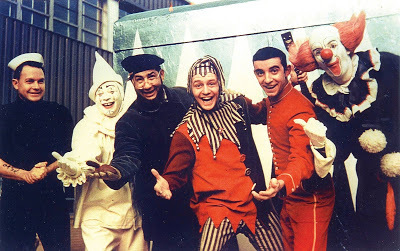 Poopdeck Paul, Milky the Clown, Captain Jolly, Jingles, Johnny Ginger, and Bozo the Clown.
Poopdeck Paul, Milky the Clown, Captain Jolly, Jingles, Johnny Ginger, and Bozo the Clown.Late in 1950, Twin Pines Dairy wanted to sponsor a children's show with cartoons, western movies, and a magic clown called Milky. The dairy owner had seen magician Clare Cummings perform in the Detroit area and offered him the job. Cummings created the Milky makeup and his wife made his costume patterned after the clown in the opera Pagliacci. Milky the Clown was born. Between commercial breaks, Milky performed magic tricks and hosted the day's movie. When he performed his tricks, Milky would always say the magic words "Twin Pines."
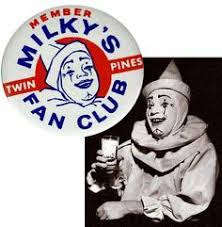
In the days of only four TV broadcasters in the Detroit area, Milky worked at all three American channels. Milky's Movie Party debuted on December 16, 1950 at WJBK-channel two. In 1955, Milky moved to WXYZ--channel seven with the same show except with Little Rascals shorts. In 1958, the show moved for the last time to WWJ--channel four with a slightly different title Milky's Party Time.
Party Time included a live audience and competitions between boys and the girls. Winners would chose a prize from the Twin Pines Toy House. Milky the Clown ended for Cummings in 1964 when he gave up the costume and makeup to make more money in industry.
Clare Cummings died on October 31, 1994, the same day as another noteworthy magician's death in Detroit in 1926--Harry Houdini. Cummings donated most of his magic tricks and one of his costumes to the American Museum of Magic in Marshall, Michigan. They are on permanent display.
***
 In 1957, Windsor, Ontario broadcaster CKLW--channel nine purchased 234 Max Fleisher Popeye cartoons and they were looking for someone to host Popeye and Friends for their 6:00 pm time slot. Toby David portrayed Captain Jolly. Captain's Jolly's first mate was Poopdeck Paul portrayed by Paul Schultz, who worked the weekend slot. The show was popular but ended in 1964 when CKLW cancelled the show. Captain Jolly would address his kiddie audience as his "Chipmates" in his best, bad-German accent.
In 1957, Windsor, Ontario broadcaster CKLW--channel nine purchased 234 Max Fleisher Popeye cartoons and they were looking for someone to host Popeye and Friends for their 6:00 pm time slot. Toby David portrayed Captain Jolly. Captain's Jolly's first mate was Poopdeck Paul portrayed by Paul Schultz, who worked the weekend slot. The show was popular but ended in 1964 when CKLW cancelled the show. Captain Jolly would address his kiddie audience as his "Chipmates" in his best, bad-German accent. ***

Jerry Gale was working as a stand-up comedian in Toledo, Detroit, and Windsor scratching out a living. In 1957, he auditioned for a new WXYZ program showing Three Stooges shorts called Curtain Time. The station manager insisted that Gale work under the name Johnny Ginger. Ginger's character was dressed as a stagehand in bib overalls. He would open the curtain and close the curtain for every show. Curtain Time ran from 1957 until 1960 when the show was rebranded under the name The Johnny Ginger Show, running from 1960 through 1968. Ginger changed his costume to a bellhop uniform and became a fan favorite.
***
Jingles in Boofland was purchased from a Fort Wayne, Indiana station by CKLW in 1958 for their weekly 5:00 pm time slot. Jerry Booth's character was a court jester and not a clown. He wore no makeup. His costume covered with bells jingled whenever he moved.
Jingles lived in the mythical kingdom of Boofland--a play on Booth's last name. The show did not have a studio audience to compromise the fantasy of the medieval castle, the parapet, the archway, and several set pieces which allowed kids watching at home to work their imaginations. His two sidekicks were puppets, Herkimer Dragon and Cecil B. Rabbit.
 Herkimer, Jingles, and Cecil B.Jingles played the straight man reacting to the puppets' eccentric behaviors. The rabbit was a bossy know-it-all. The dragon was a soft-spoken buffoon who did stupid things all the time. Occasional puffs of smoke would come out of Herkimer's mouth. Inside the puppet's head was a tube. Off-stage actor and voice of the puppets Larry Sand would light up a cigarette and blow smoke through the tube creating a fire-breathing dragon effect.
Herkimer, Jingles, and Cecil B.Jingles played the straight man reacting to the puppets' eccentric behaviors. The rabbit was a bossy know-it-all. The dragon was a soft-spoken buffoon who did stupid things all the time. Occasional puffs of smoke would come out of Herkimer's mouth. Inside the puppet's head was a tube. Off-stage actor and voice of the puppets Larry Sand would light up a cigarette and blow smoke through the tube creating a fire-breathing dragon effect.Jingles's comedy skits and running gags were wrapped around the Warner Brothers cartoons and Laurel and Hardy shorts that the program served up. Jingles in Boofland ended in the early sixties.
***
 CKLW Detroit/Windsor Bozo--Art CerviThe original Bozo the Clown was created by Alan W. Livingston in the 1940s for a storytelling record album. The character first appeared on TV in 1949. The rights to Bozo were purchased in 1956 by Larry Harmon. Harmon franchised the character across America, so every major television market had their own Bozo the Clown showing Bozo cartoons.
CKLW Detroit/Windsor Bozo--Art CerviThe original Bozo the Clown was created by Alan W. Livingston in the 1940s for a storytelling record album. The character first appeared on TV in 1949. The rights to Bozo were purchased in 1956 by Larry Harmon. Harmon franchised the character across America, so every major television market had their own Bozo the Clown showing Bozo cartoons.In 1965 when cable TV was taking hold, Harmon began to syndicate Bozo's Circus from Chicago and took the show to a national audience. Individual stations no longer needed their own Bozos, nor could they compete with the new format. In 1978, the show was bouncing off satellites and appearing worldwide.
Bob McNea was Detroit's first Bozo for WWJ from 1959-1967. Jerry Booth took over the role for CKLW but lasted only a month. Booth did not like putting on the heavy stage makeup or the anonymity of being Bozo. Art Cervi took over the role. He donned the red wig and clown suit from 1967 through 1979 when his contract ran out.
The above photo of Bozo needs some context. Bozo was doing a live appearance in Tiger Stadium. His makeup and wig are exaggerated so the crowd could see him from a distance. "Whoa, Nelly!" Normally, he wasn't that scary.
***
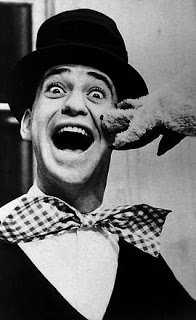 No survey of Detroit's kid show hosts would be complete without mention of the King of Detroit Kiddie Comedy--Soupy Sales. His show Lunch with Soupy ran at noon on WXYZ from 1953 until 1960.
No survey of Detroit's kid show hosts would be complete without mention of the King of Detroit Kiddie Comedy--Soupy Sales. His show Lunch with Soupy ran at noon on WXYZ from 1953 until 1960.I remember Lunchtime as a half-hour romp of slapstick, word play, and improvisation. Soupy's signature trademarks were the "pie in the face" and his dance the "Soupy Shuffle." No cartoons, just Soupy and his puppets White Fang, Black Tooth, and Pookie.
Most people are unaware that Milton Supman (Soupy Sales) held a master's degree in journalism. Soupy warrants his own post:
https://fornology.blogspot.com/2017/06/lunch-with-soupy-sales-in-detroit.html
Published on March 08, 2020 12:00
February 28, 2020
Elusive Purple Gang April 2020 Book Tour
 If you are interested in Detroit's one-hundred-year-old Prohibition history, I'll be in the Detroit area giving book talks on
The Elusive Purple Gang: Detroit's Kosher Nostra
early in April. Stop by.
If you are interested in Detroit's one-hundred-year-old Prohibition history, I'll be in the Detroit area giving book talks on
The Elusive Purple Gang: Detroit's Kosher Nostra
early in April. Stop by.Sunday, April 5th - Saline Public Library's Brecon Room sponsored by the Saline Historical Society, 555 N. Maple Rd., Saline, MI 48176. 2:00 PM
Wednesday, April 8th - Southgate Veterans' Memorial Library, 14680 Dix Toledo Rd., Southgate, MI 48195. 7:00 PM
Thursday, April 9th - Wyandotte: Bacon Memorial Library, 45 Vinewood St., Wyandotte, MI 48197. 7:00 PM
Saturday, April 11th - Romeo Public Library, 65821 Van Dyke, Washington, MI 48095. 6:00 PM
Tuesday, April 14th - Metropolitan Detroit Jewish Community Center, 6600 W. Maple Rd., West Bloomfield Township, MI 48322. 12:00 PM
*****
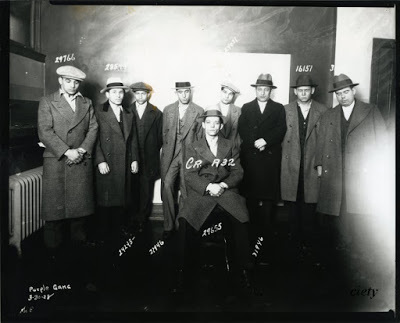 Purple Gang footsoldiers defiantly pose for a roundup photo--March 31, 1928.
Purple Gang footsoldiers defiantly pose for a roundup photo--March 31, 1928. On Sunday, July 19th, 2020, look for me at Detroit Bookfest 4 in the Eastern Market, Shed 3, 2934 Russell St., Detroit, MI 48207. This is one of Detroit's premier summer events. 10:00 AM - 4:00 PM. Incidently, The Eastern Market was an early Purple Gang hangout.
Elusive Purple Gang Amazon Site
Published on February 28, 2020 06:52
February 21, 2020
The Elusive Purple Gang Audio Now Available
 Rich MillerAt last, the audio of my latest true crime book The Elusive Purple Gang: Detroit's Kosher Nostra is available from Amazon, Audible.com, and iTunes. I wanted a professional voice artist, recording on professional recording equipment. My publisher Wheatmark Inc. recommended Rich Miller and arranged for him to make a demo recording of my first chapter. I liked it.
Rich MillerAt last, the audio of my latest true crime book The Elusive Purple Gang: Detroit's Kosher Nostra is available from Amazon, Audible.com, and iTunes. I wanted a professional voice artist, recording on professional recording equipment. My publisher Wheatmark Inc. recommended Rich Miller and arranged for him to make a demo recording of my first chapter. I liked it.I met with Rich in Tucson, Arizona, and discovered he has an acting background ranging from Shakespeare to modern theater like Damn Yankees and August: Osage County. He has worked in theatrical sound design and done voice over work in television commercials.
 Now, Rich operates his own recording studio and acts out stories in front of a microphone. He is the creator and host of a podcast named The Audiobook Speakeasy aimed at narrators, offering them content from audio coaches, sound engineers, casting directors, and contract specialists.
Now, Rich operates his own recording studio and acts out stories in front of a microphone. He is the creator and host of a podcast named The Audiobook Speakeasy aimed at narrators, offering them content from audio coaches, sound engineers, casting directors, and contract specialists. I chose Rich to narrate The Elusive Purple Gang because I wanted someone who could read my book in a conversational tone to make the storytelling more engaging for the listener. Rich's subtle voice characterizations make listening a pleasure.
Rich Voice Productions
Published on February 21, 2020 07:16
February 11, 2020
Allen Park's Uniroyal Giant Tire--Fifty-Nine Years Old--Heralds Entrance into The Motor City

The original U.S. Royal Tire exhibit was a Ferris wheel attraction at the New York World's Fair of 1964/1965, held in Flushing Meadows Corona Park in the borough of Queens. The fair was open for two six-month seasons. In 1964, it was open from April 22th until October 18th, and in 1965, the dates were April 21st until October 17th.
The history of the U.S. Royal Giant Tire is pretty straightforward. Originally rigged as a Ferris wheel and powered by a 100 HP engine, it was over eighty feet high. It carried close to 2,000,000 people at the World's Fair, many of them famous world figures. There were twenty-four barrel shaped gondolas, each carrying up to four people for a total of ninety-six passengers paying a quarter apiece.
 At the fair's end, the tire was disassembled and shipped in twenty-one truck loads to Detroit and reassembled as a static display outside the Uniroyal sales offices in Allen Park, Michigan. It is one of the world's largest roadside attractions. The Uniroyal office has since moved, but the Giant Tire still stands.
At the fair's end, the tire was disassembled and shipped in twenty-one truck loads to Detroit and reassembled as a static display outside the Uniroyal sales offices in Allen Park, Michigan. It is one of the world's largest roadside attractions. The Uniroyal office has since moved, but the Giant Tire still stands.The tire is not made of rubber, but sightseers don't notice the difference whizzing past the landmark at seventy miles an hour on Interstate 94. The tire weighs just under twelve tons and is anchored in twenty-four feet of concrete and structural steel. It is rated to withstand hurricane force winds.
 When the Michelin Tire Company bought out Uniroyal and Goodrich in 1990, they renovated the landmark in 1994 with a fresh coat of paint, a modern looking hubcap, and neon lights for the Uniroyal lettering. Four years later in 1998, the Giant Tire was modified again to resemble a "Nail Guard" tire. An eleven foot long, 250 pound nail (world's largest) was sticking out from the tire to promote their new puncture proof product. The nail was put up for auction on eBay in 2003 and sold for $3,000, with proceeds donated to the Allen Park Historical Museum.
When the Michelin Tire Company bought out Uniroyal and Goodrich in 1990, they renovated the landmark in 1994 with a fresh coat of paint, a modern looking hubcap, and neon lights for the Uniroyal lettering. Four years later in 1998, the Giant Tire was modified again to resemble a "Nail Guard" tire. An eleven foot long, 250 pound nail (world's largest) was sticking out from the tire to promote their new puncture proof product. The nail was put up for auction on eBay in 2003 and sold for $3,000, with proceeds donated to the Allen Park Historical Museum.In 2003, the Giant Tire was once again renovated as part of the I-94 corridor revitalization. The neon lettering was replaced with reflective lettering and spotlighting. It has remained a Detroit landmark and an Allen Park roadside attraction for fifty-three-years heralding the entrance into the Motor City from Detroit Metropolitan Airport in Romulus, Michigan.
It has been noted that the one thing the Beatles wanted to see on their American tour was the Giant Tire. Whether they stopped along the freeway to take a good look at it on their way into Detroit from Metro Airport isn't known, but when Paul McCartney and Wings were touring in 1976, the moment was commemorated.

http://www.freep.com/article/20120312/COL14/203120336/Mark-Phelan-You-ve-seen-the-Giant-Tire-now-see-inside-of-it
For more detailed information on the Detroit's Big Wheel, consult The Giant Tire by Steve J. Frey: http://www.gianttire.info/?fbclid=IwAR2HT6p9Cva5dHSNZl-Ff0dRj053V6Eu--R5FuZtyauH3alhNuDMtladjkM
Published on February 11, 2020 13:34
February 1, 2020
Elusive Purple Gang Wins Book Cover of the Month Award for February 2020
 San Diego Library Local Author Showcase--January 31th, 2020.
San Diego Library Local Author Showcase--January 31th, 2020.We have all heard the advice "Don't judge a book by its cover," but an engaging book cover can capture a reader's attention and act as a calling card to pick up the book and read the back cover. Of course, if the contents of the book are shoddy, the author loses a reader for life.
I was surprised to win a Book Cover of the Month Award for February 2020. Although the cover of The Elusive Purple Gang: Detroit's Kosher Nostra doesn't depict known Purple Gang members, it does quickly establish the time and place of the book. What is not so apparent is a subtle design feature that creates a sense of depth which draws the eye in.
Kudos go to Wheatmark Inc. cover designer Micah Edel. After I provided the cover photo and a rough idea of what I was looking for, Micah did the rest. Our most difficult decision was choosing the right shade of purple for the title. The shade was either too bright and festive or too dark and oppressive. Finally, I hit on it--make the title Crayola purple. It worked!
Contest organizer Pam Rice critiqued the cover this way, "The black and white photo is dramatic and makes a statement. The title is also telling the story. The font is simple with just enough of a serif to make it interesting. The background has a great texture but doesn't overpower the font or the image."
 I appreciate this honor and acknowledgement, but I have only one problem. I like the cover so much that I don't want to hide it behind a medallion. Bragging rights will have to do.
I appreciate this honor and acknowledgement, but I have only one problem. I like the cover so much that I don't want to hide it behind a medallion. Bragging rights will have to do.gregoryafournier.com
Published on February 01, 2020 10:04
January 26, 2020
Samuel Zug - The Man Behind the Island
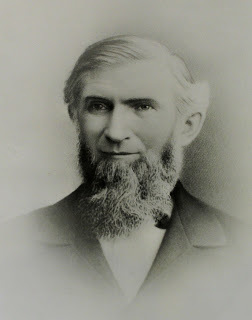 Samuel ZugAt the end of June 2013, I was asked by Canadian filmmaker, Mark Dal Bianco, to write a brief biography of Samuel Zug, the man who Zug Island is named after.
Samuel ZugAt the end of June 2013, I was asked by Canadian filmmaker, Mark Dal Bianco, to write a brief biography of Samuel Zug, the man who Zug Island is named after. The filmmaker is producing a documentary on the environmental impact of the island on the surrounding areas of Detroit and Windsor.
Mr. Zug is thought by some people to have been an industrialist, but that couldn't be further from the truth. He was a devout Presbyterian who took an interest in politics and human rights.
In 1836 at the tender age of twenty years old, Samuel Zug came to Detroit, Michigan from Cumberland County, Pennsylvania. Using money he saved as a bookkeeper in the Pittsburgh area, he went into the furniture making business with Marcus Stevenson, a Detroit investor.
The prospect of endless stands of pine, oak and maple trees as raw material, and convenient access to Eastern markets by way of the Detroit River for their finished products, made Detroit an ideal place for a young man to make his fortune.
But in 1859 after twenty-three years in the furniture business, his partnership with Stevenson was dissolved leaving Samuel Zug a wealthy man to pursue real estate and political ambitions.
In 1859 (or 1876 depending on which source you choose), Samuel Zug purchased 325 acres of land along the Detroit River from Michigan's second Territorial governor, General Lewis B. Cass. Over 250 acres of the parcel was marshland with a sulfur spring bubbling up 1,200 barrels of mineral water a day.
The marshy peninsula of land was a part of Ecorse Township before it became the city of River Rouge. In unrecorded time, the land was rumored to have been an ancient burial site for a number of native American tribes who were known to inhabit the area.
Samuel Zug and his wife Anna hoped to build a mansion on the island, but after ten years they decided that the marshland and natural sulfur spring on the site proved too much for them to endure. The Zugs surrendered the land to the red fox, water fowl, muskrats, and mosquitoes. The croaking frogs and singing insects were left to serenade the damp night air because the island was virtually uninhabitable.
In 1888, Samuel Zug authorized the River Rouge River Improvement Company to cut a small canal at the south end of his land. Known by locals as Mud Run, it was dredged out sixty feet wide and eight feet deep.
 Short Cut Canal at bottom of map was Mud Run.
Short Cut Canal at bottom of map was Mud Run.The Zug family peninsula became a man-made island overnight separating it from the north end of Ecorse Township. The channel improved the flow of the Rouge River into the Detroit River, but it did little to circulate water around the newly formed island, leaving a slow-moving backwater.
On December 26, 1889, Samuel Zug died leaving his holdings to his wife, Anne, who died on June 10th,1891. It has been reported wrongly that Mr. Zug died in 1896. My source for the correct date of Zug's death comes from his huge tombstone in Detroit's Elmwood Cemetery.
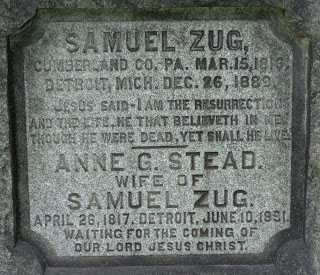
The Zug heirs sold the island for $300,000 to George Brady and Charles Noble, who wanted to use the site for an industrial dumping ground. The island was diked with interlocking steel panels and back-filled with construction rubble and dredging waste to raise the ground above the water table and reclaim the land from its natural state.
Heavy industry was about to move onto the island but Mr. Zug never lived to see it. The island's namesake was "Waiting for the Coming of Our Lord" as the inscription on his grave marker proclaims.
In addition to being a bookkeeper and the owner of a successful furniture manufacturing company, Samuel Zug is also credited with being one of the founding members of the Republican Party, which was considered to be the progressive party of the day. Their first official meeting took place on July 6, 1854, in Jackson, Michigan.
The Republicans were an abolitionist party that came to national attention when they won 33% of the presidential vote from the Democrats and the Whigs in 1856. Four years later in 1860, they broke through the two-party system and elected Abraham Lincoln to the White House.
Samuel Zug was an anti-slavery advocate long before Lincoln was elected and The Civil War began. He bought and set aside a parcel of land for refugee slaves in the city of Amherstburg, Ontario, Canada, a destination of the Underground Railroad. What other support he gave to the Abolitionist Movement is shrouded in the dim history of time and whispers of the unrecorded past.
At the time of his death, Samuel Zug was unaware of the mighty industrial complex his soggy marshland would become. He would never know the history Zug Island would help make possible or the long term environmental impact the rust belt industry would have on the area and its people.
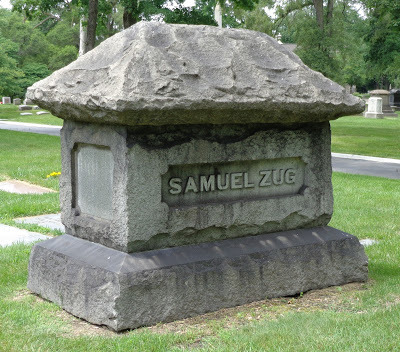 In Detroit's Elmwood Cemetery
In Detroit's Elmwood CemeteryZug Island to close operations by April.
Published on January 26, 2020 08:46
January 16, 2020
Fornology Blog 2020--Closing in on a Million Hits

After almost ten years of blogging, my Fornology.com site will register a million hits this year. Writing blog posts has become my favorite type of writing because of the instant gratification and immediacy of reader response. What also appeals to me is a post can be endlessly revised to correct any content or grammar errors, which is not the case with published longer works where your words are imprisoned on the page.
When I began to blog at the urging of my first publicist in 2011, I was less than thrilled. I knew nothing of blogging, so I did what any self-respecting Baby Boomer would do, I bought a hard copy of Blogging for Dummies. There is no shortage of books about monetizing your blog, but I needed advice on how to build a blog.
Once I understood the nature of the beast, I began to recognize the value of building an audience by drawing readers to my site. Blogging has become my primary marketing vehicle because of its long reach and its cost--blogging is essentially free. All of my posts are offered for free, but my longer works can be purchased in my blog's sidebar. I prefer the soft rather than the hard sell.
 At first, my post topics were random, but soon I focused on topics related to my longer works creating interest in my books' subjects. Not only did my blog become a research tool, it helped me develop my author's voice and writing style, all the while growing my audience.
At first, my post topics were random, but soon I focused on topics related to my longer works creating interest in my books' subjects. Not only did my blog become a research tool, it helped me develop my author's voice and writing style, all the while growing my audience.What is remarkable to me is that I've written 445 posts over the last nine years. My present goal is to reach 500 posts before I pull the plug and call it a career.
Top Ten Fornology Posts
Published on January 16, 2020 09:00
January 9, 2020
Purple Gangster Marries Shiksa
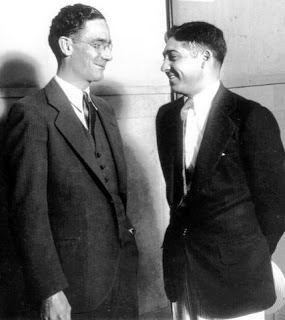 Edward Kennedy Jr. and Joseph Burnstein.Most Purple Gang members made their mothers proud by marrying Jewish women and following the precepts of their Hebrew faith--on the surface anyway. One notable exception was twenty-eight-year-old Joseph Burnstein who married a nineteen-year-old Catholic show girl from Kenosha, Wisconsin named Marguerite Ball.
Edward Kennedy Jr. and Joseph Burnstein.Most Purple Gang members made their mothers proud by marrying Jewish women and following the precepts of their Hebrew faith--on the surface anyway. One notable exception was twenty-eight-year-old Joseph Burnstein who married a nineteen-year-old Catholic show girl from Kenosha, Wisconsin named Marguerite Ball.After graduating from dance school, Marguerite began her show business career in vaudeville with the Paul Ash Revue performing live musical skits on-stage in Chicago movie houses before the evening's silent film was shown. These small productions were broadcast over local radio from 7:15 pm to 8:00 pm.
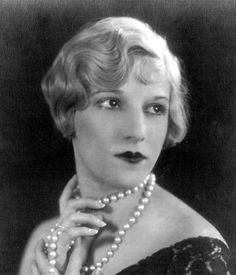 Marguerite (Ball) BurnsteinMarguerite performed in short musical pieces named "May Time Jazz Carnival," "Oh, Teacher," "Shanghai Dreams," and "Paul's Hot Ashes." She was talented enough to capture the notice of George White, a show business impresario of variety shows called the George White Scandals--along the line of the more famous and elegant Ziegfeld Follies. Marguerite performed on Broadway in "Manhattan Mary" and "Helen, In the Scandals" as an uncredited cast member.
Marguerite (Ball) BurnsteinMarguerite performed in short musical pieces named "May Time Jazz Carnival," "Oh, Teacher," "Shanghai Dreams," and "Paul's Hot Ashes." She was talented enough to capture the notice of George White, a show business impresario of variety shows called the George White Scandals--along the line of the more famous and elegant Ziegfeld Follies. Marguerite performed on Broadway in "Manhattan Mary" and "Helen, In the Scandals" as an uncredited cast member.The details of Joe and Marguerite's courtship are unknown, but it can be safely said that theirs was a whirlwind romance culminating in marriage on March 23, 1929 in Detroit. Their newspaper wedding notice described Joe as the vice-president of a Detroit motor company--a lie designed for the benefit of the Ball family who surely had reservations about Marguerite's hasty Justice of the Peace marriage to a man they knew little about. The newlyweds moved into a custom Tudor-style home said to be valued at $100,000 in the exclusive Detroit suburb of Palmer Woods.
Joe was the most business-minded of the Burnstein brothers and owned a number of legitimate businesses used to launder gang money and provide fronts for other gang activities. He owned an auto parts business, a men's fine clothing store, a three-chair barber shop (on the site of the current Fox Theater), and oil wells in Mt. Pleasant and Clare, Michigan. Outwardly, Joe had all the trappings of a prosperous and legitimate businessman--including a trophy wife.
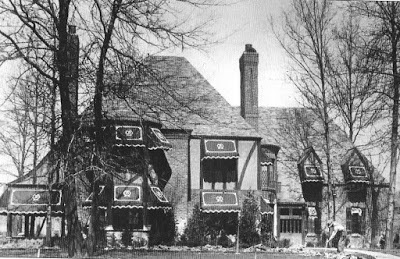 Joseph Burnstein's mansion--notice the B emblem on the awnings.A scant year passed before Marguerite gave birth to a healthy daughter. Her married life with Joe seemed idyllic until fate reared its ugly head. One week after Marguerite gave birth to their child, Joe was fighting for his life in the same hospital. One of his business partners--while on an opium binge--shot Joe in the midriff hitting his spleen.
Joseph Burnstein's mansion--notice the B emblem on the awnings.A scant year passed before Marguerite gave birth to a healthy daughter. Her married life with Joe seemed idyllic until fate reared its ugly head. One week after Marguerite gave birth to their child, Joe was fighting for his life in the same hospital. One of his business partners--while on an opium binge--shot Joe in the midriff hitting his spleen.Joe almost bled out, but Purple Gang members lined up at Detroit Receiving Hospital donating blood to help save his life. True to the gangster code, Joe refused to testify against his assailant Harry Kirschenbaum. They were friends and Joe said all he remembered was bumping his head and passing out. Kirschenbaum was acquitted in Detroit Recorder's Court but was convicted later on a federal narcotics charge for possession of opium.
When Joe recovered sufficiently from his stomach wound and returned home from the hospital, Marguerite gave him an ultimatum, "Either quit the gang or say goodbye to me and your daughter."
Leaving the day-to-day gang life behind, Joe cast his eyes west and eventually settled in El Dorado, California where he became a consultant to Reno and West Coast gambling concerns. After his brother Ray was convicted of first-degree murder and sent to Marquette Prison for life, youngest brother Isadore moved to California also, leaving oldest brother Abe to run the gang's gambling rackets.
Joe and Marguerite remained married for fifty-five years until he died of heart failure at the age of eighty-four on February 28, 1984. Marguerite died on January 9, 1992 in El Dorado, California at the age of eighty-one. Of the four Burnstein brothers, Joe was the only one with a lasting marriage and two daughters to show for it.
Mobsters' Women
Published on January 09, 2020 07:30
January 2, 2020
Mobsters' Women
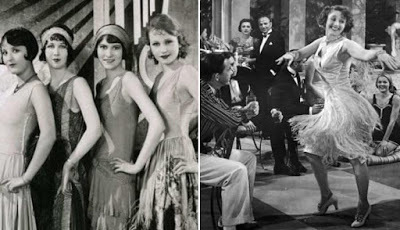 The age of the flapper--1920s
The age of the flapper--1920sOnce World War I ended and the doughboys returned from Europe, young men and women were ready to shed the Victorian inhibitions of the past for the freedom of modernity. While the soldiers were off fighting the Germans, women won their voting rights and Temperance groups made national Prohibition the law of the land.
The alchemy of these new political realities dramatically impacted society setting the stage for the Roaring Twenties and the age of the flapper. Young women shed their corsets, raised their hemlines, lowered their waistlines, bobbed their hair, and put on shoes with heels. They smoked, they swore, they drank, and they danced to the latest syncopated rhythms at speakeasies while rubbing elbows with underworld figures and wealthy local businessmen.
Many young women were attracted to the lavish lifestyle of underworld figures who dressed in fine clothes and drove flashy automobiles. As long as the money and perks rolled in, most gangster wives and girlfriends knew better than to question the source of their good fortune--they were smart enough to play dumb.
But being involved with a gangster was a risky proposition for women. Gangsters of the Roaring Twenties tended to die young leaving their wives and girlfriends bereaved and destitute. Some young women hooked up with other gangsters, some returned home to their families, some returned to the chorus line from whence they came, and some went to work in a variety of low-paying jobs.
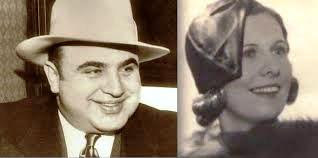 Al and Mae Coughlin CaponePlanning for the future was not a priority for people living in the moment. Life insurance and pension plans were not part of the gangster's long-term prospectus. When Al Capone died, his wife Mae was forced to vacate their Palm Island estate in Miami Beach, Florida. She went to work helping her son run a Miami restaurant called The Grotto, but when the venture failed, Mae lived modestly in Hollywood, Florida on the generosity of her brother-in-law Ralph Capone and the Chicago organization who paid her a small stipend understood to be hush money.
Al and Mae Coughlin CaponePlanning for the future was not a priority for people living in the moment. Life insurance and pension plans were not part of the gangster's long-term prospectus. When Al Capone died, his wife Mae was forced to vacate their Palm Island estate in Miami Beach, Florida. She went to work helping her son run a Miami restaurant called The Grotto, but when the venture failed, Mae lived modestly in Hollywood, Florida on the generosity of her brother-in-law Ralph Capone and the Chicago organization who paid her a small stipend understood to be hush money.In Detroit, Michigan, Purple Gang enforcers Abe Axler and Eddie Fletcher died as they lived--at the wrong end of a gun. Both men when released from federal prison had to pay $5,000 in fines. After Axler and Fletcher were released, they were broke. Shortly after that, they were found murdered in the back seat of car. Abe had $18.60 in his pockets and Eddie had $0.60. The Axler family in New York paid to ship Abe's body home for burial. Eddie Fletcher's body was also returned to New York, but his family had long-since turned their back on Eddie. His burial expenses were paid by First Brodyer Benevolent Association because of his indigence.
Neither of their widows had a financial safety net, so they played the marriage sweepstakes. Evelyn Axler remarried twice--both times to alcoholics. She died at the age of thirty-eight from second and third degree burns over her entire body. The cause of death was entered as accidental by the Wayne County Coroner though the details of her death are lost to history. Anna Fletcher fared much better. She remarried a man not in the rackets and drifted into obscurity leaving the mob life behind.
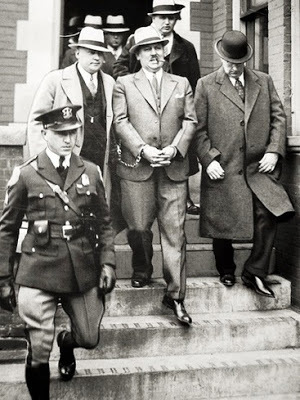 Fred "Killer" Burke after pleading guilty to murder.As a rule, most mobster wives and girlfriends were left unprovided for, but there were exceptions. Fred "Killer" Burke--gunman responsible for three of the most notorious gangland killings of the Prohibition period--had as many wives and girlfriends as he had aliases. His final marriage was to twenty-year-old Bonnie Gwendoline Porter when Burke was thirty-seven.
Fred "Killer" Burke after pleading guilty to murder.As a rule, most mobster wives and girlfriends were left unprovided for, but there were exceptions. Fred "Killer" Burke--gunman responsible for three of the most notorious gangland killings of the Prohibition period--had as many wives and girlfriends as he had aliases. His final marriage was to twenty-year-old Bonnie Gwendoline Porter when Burke was thirty-seven.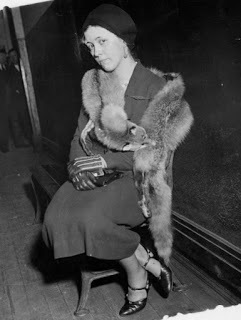 Bonnie BurkeLess than a year after their marriage in 1930, Burke was arrested for the murder of a St. Joseph, Michigan patrolman who was trying to apprehend him for a minor traffic accident. When Bonnie Burke was brought in for questioning, she said she knew nothing about her husband's criminal past and believed he sold oil well leases. "My husband spent a lot of time on the road," she told police. In reality, Burke held up banks and committed other crimes in surrounding counties and states.
Bonnie BurkeLess than a year after their marriage in 1930, Burke was arrested for the murder of a St. Joseph, Michigan patrolman who was trying to apprehend him for a minor traffic accident. When Bonnie Burke was brought in for questioning, she said she knew nothing about her husband's criminal past and believed he sold oil well leases. "My husband spent a lot of time on the road," she told police. In reality, Burke held up banks and committed other crimes in surrounding counties and states.Charged with second-degree murder, Fred Burke pleaded guilty knowing there was a contract put out on him for double-crossing the Purple Gang. He was sentenced to life at Marquette Prison in Michigan's Upper Peninsula where he died of heart failure in 1940. Despite not visiting Burke in the nine years he spent behind bars, Bonnie was left with a fortune in negotiable United States Treasury
Bonds leaving her a very rich woman.
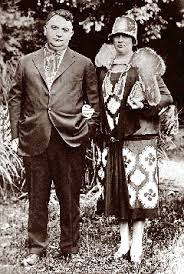 Chester and Anna LaMareAnother exception to the plight of most mob wives was Anna LaMare, the wife of Cesare "Big Chet" LaMare--Hamtramck, Michigan mob boss and Wyandotte, Michigan Mafia don. In a move to become capo regime ("boss of bosses"), LaMare attempted to gather Detroit's Mafia leaders together in one place to assassinate them in one fell swoop. The plan unravelled and two low-ranking Eastside Mafia members were shot to death igniting a year-long Mafia gang war between Eastside and Westside Mafia factions--only one would survive. LaMare knew his days were numbered. A month before he was assassinated by turncoat members of his own gang, LaMare discussed his estate and other holdings with Anna.
Chester and Anna LaMareAnother exception to the plight of most mob wives was Anna LaMare, the wife of Cesare "Big Chet" LaMare--Hamtramck, Michigan mob boss and Wyandotte, Michigan Mafia don. In a move to become capo regime ("boss of bosses"), LaMare attempted to gather Detroit's Mafia leaders together in one place to assassinate them in one fell swoop. The plan unravelled and two low-ranking Eastside Mafia members were shot to death igniting a year-long Mafia gang war between Eastside and Westside Mafia factions--only one would survive. LaMare knew his days were numbered. A month before he was assassinated by turncoat members of his own gang, LaMare discussed his estate and other holdings with Anna.While Anna was out of the house on February 6, 1931, from 9:00 pm until near midnight, two gunmen--Joe Amico and Elmer Macklin--shot Big Chet. Anna returned home and found her husband in a bleeding heap on the kitchen floor. She called the Wyandotte Police screaming into the phone at them. After they arrived, Anna calmed down and was questioned claiming she was out of the house for only an hour or so. When she left the house, Chet was by himself she told investigators. Because of the coagulation of LaMare's blood and the level of rigor mortis in his body, the coroner knew Anna was lying. LaMare had been dead for over two hours.
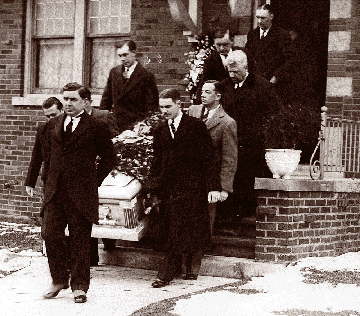 Chester LaMare's silver-clad casket being carried out of his Wyandotte homeThough Anna was suspected by police investigators as being complicit in some way, she was never charged and held only briefly before being released to arrange for her husband's funeral. Two of LaMare's foot soldiers were charged with Big Chet's murder while Anna walked away scott-free with an estate valued at $500,000--including money in the bank, extensive real estate holdings, and a Ford Motor Company dealership.
Chester LaMare's silver-clad casket being carried out of his Wyandotte homeThough Anna was suspected by police investigators as being complicit in some way, she was never charged and held only briefly before being released to arrange for her husband's funeral. Two of LaMare's foot soldiers were charged with Big Chet's murder while Anna walked away scott-free with an estate valued at $500,000--including money in the bank, extensive real estate holdings, and a Ford Motor Company dealership.Most women involved with underworld figures were married to woe, and few profited from their association with a gangster. But all of them carried the weight of memory and the stigma of being a gangster's woman to their graves.
Published on January 02, 2020 07:53
December 15, 2019
Fornology.com : Gaslighting--A Sociopath's Favorite Tool
Fornology.com : Gaslighting--A Sociopath's Favorite Tool: The psychological phenomenon known as gaslighting has become a colloquial term to describe a form of mental abuse where a dominant i...
Published on December 15, 2019 09:20



